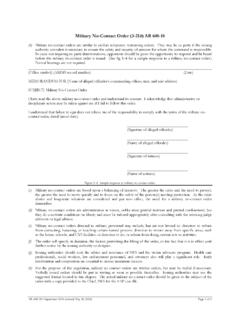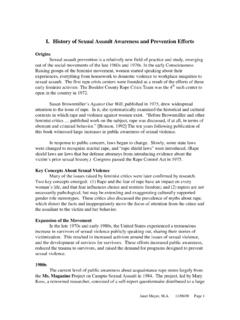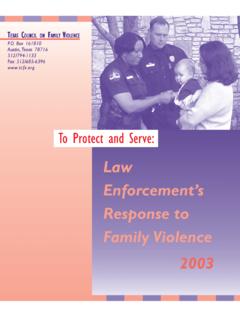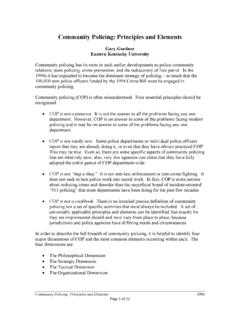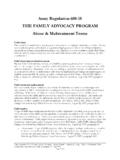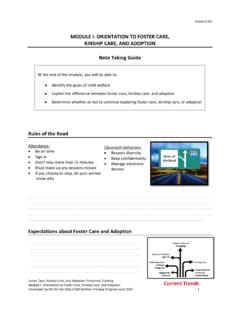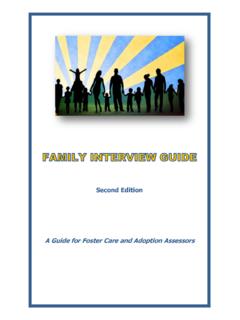Transcription of Statutory Rape: A Guide to State Laws and …
1 Statutory Rape: A Guide to State laws and reporting requirements Prepared for: Office of the Assistant Secretary for Planning and Evaluation, Department of Health and Human Services Prepared by: Asaph Glosser Karen Gardiner Mike Fishman December 15, 2004. Available On-line: 352695. Acknowledgements Work on this project was funded by the Office of the Assistant Secretary for Planning and Evaluation in the Department of Health and Human Services under a contract to The Lewin Group. This report benefited greatly from the oversight and input of Jerry Silverman, the ASPE Project Officer.
2 In addition, we would like to acknowledge the assistance of a number of reviewers. Sarah Brown, Eva Klain, and Brenda Rhodes Miller provided us with valuable guidance and insights into legal issues and the policy implications of the laws and reporting requirements . Their comments improved both the content and the organization of the paper. At The Lewin Group, Shauna Brodsky reviewed drafts and provided helpful comments. The Authors 352695. Table of Contents I. EXECUTIVE A. 1. Criminal ES-1. 2. reporting requirements .. ES-2. B. Implications for Program Staff and Policy C.
3 Structure of II. A. Project B. Methodology ..2. 1. Terminology ..2. 2. Types of 3. III. SUMMARY OF CURRENT State laws ..5. A. Statutory Rape Criminal Offenses ..5. 1. Sexual Intercourse with 2. Definition of Offenses ..9. B. Child Abuse reporting requirements ..10. 1. Inclusion of Statutory Rape in reporting 2. Mandatory 3. Who to Report 4. State IV. State ARIZONA ..22. CALIFORNIA ..26. COLORADO ..29. DISTRICT OF FLORIDA ..37. GEORGIA ..39. HAWAII ..41. IDAHO ..43. 352695. MICHIGAN ..65. MISSOURI ..71. NEBRASKA ..75. NEW HAMPSHIRE ..79. NEW JERSEY.
4 81. NEW MEXICO ..83. NEW NORTH NORTH DAKOTA ..90. OHIO ..92. PENNSYLVANIA ..99. RHODE SOUTH CAROLINA ..103. SOUTH TEXAS ..110. UTAH ..112. 352695. WEST VIRGINIA ..121. 352695. Executive Summary I. EXECUTIVE SUMMARY. In 2003, the Office of the Assistant Secretary for Planning and Evaluation (ASPE) within the Department of Health and Human Services (HHS) contracted with The Lewin Group to explore how three federally funded programs that have contact with adolescents Title X family planning clinics, Health Resources and Services Administration-supported health centers, and child protective services address Statutory rape within their client populations.
5 The multi- phase, descriptive study will collect information about State laws , federal guidance to programs, and grantees' and local offices' practices. The findings will help HHS to determine if additional guidance is needed. This report is a compilation of State laws and reporting requirements . It provides an overview of State Statutory rape laws and reporting requirements , as well as a summary of laws for each State and the District of Columbia. This report is not intended to be a legal document. It is designed to provide useful information to State and federal policymakers who are interested in how State statutes address Statutory rape.
6 It also is intended to serve as a resource for HHS grantees. A. Background To understand if Statutory rape has occurred and whether it should be reported (and to whom), program staff and policy makers need to be familiar with two sets of laws : criminal and civil codes. The former deals with the legality of sexual activities involving minors, while the latter describes individuals' reporting responsibilities. In short, there is no one size fits all law that guides the identification and reporting of Statutory rape. Rather, there is wide variation in State codes.
7 What is a reportable offense in one State may be outside the purview of law enforcement or child protective services in another. 1. Criminal laws Criminal laws deal with the legality of sexual acts. Statutory rape laws assume that all sexual activities involving individuals below a certain age are coercive. This is true even if both parties believe their participation is voluntary. Generally, Statutory rape laws define the age below which an individual is legally incapable of consenting to sexual activity. To complicate matters, few states use the term Statutory rape in their criminal codes.
8 More often, a State 's code will address legality of different sexual activities involving minors ( , sexual contact versus penetration). Sometimes it is difficult to identify the applicable laws because they are often embedded in the section of the code dealing with other sexual offenses ( , sexual assault, forcible rape). A common misconception about Statutory rape is that there is a single age at which an individual can legally consent to sexual activity. In fact, only 12 states have a single age of consent; in these states , this age ranges from 16 to 18 years old.
9 In the remaining states , the age of consent depends on one or more of the following factors: age differences between the partners, the age of the victim, and the age of the defendant. Each is described below. The following exhibit illustrates how the age of consent interacts with these three elements. The examples are actual State laws . ES-1. 352695. Executive Summary State Age of Consent Minimum Age: Age Differential Minimum Age: Victim Defendant A 18 -- -- -- B 16 -- 4 -- C 16 13 4 -- D 16 16 -- 18. State A has a single age of consent. In this State , a male or female under age 18 cannot consent to sex, regardless of the age of the other party.
10 Thus, sexual relations between two 17-year-olds would be illegal, as would relations between a 17-year-old and a 25-year-old. Age differential. A number of State codes specify age ranges outside of which parties cannot consent to sex. In State B, sex with an individual under 16 years of age is illegal if the other party is four or more years older. Thus, sexual relations between a 15-year-old and an 18-year-old would be legal, while the same relationship between a 15-year-old and a 21- year old would not. Minimum age of victim. Some State codes define the age below which an individual cannot legally engage in sexual activities, regardless of the age of the other pa rty.

